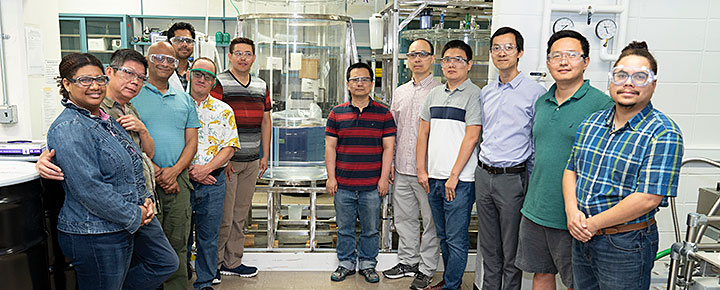PROSPECT Experiment Garners Lawrence Livermore S&T Award
Recognition for team behind first above-ground detection of antineutrinos at experiment seeking evidence of new neutrino type
September 30, 2019
 enlarge
enlarge
Brookhaven Lab members of the PROSPECT team pictured in the liquid scintillator production facility used for outfitting neutrino detectors (left to right): Rayzeline Diaz Perez, Minfang Yeh, Milind Diwan, Sasmit Gokhale (rear), David Jaffe, Richard Rosero, Chao Zhang, Manhong Zhao, Xiangpan Ji, Aiwu Zhang, Xin Qian, Christopher Camilio Reyes.
The PROSPECT neutrino experiment was one of four projects recently recognized by the U.S. Department of Energy’s (DOE) Lawrence Livermore National Laboratory (LLNL) with a 2019 Director’s Science & Technology (S&T) Award. Similar to Brookhaven National Laboratory’s S&T awards, these awards recognize recent significant scientific and technical accomplishments by LLNL staff and their collaborators. Scientists from Brookhaven Lab (BNL) are among those collaborators and share in this outstanding recognition.
“Team science is at the heart of how we approach advancement of science and technology and deliver on our mission challenges,” said Patricia K. Falcone, LLNL’s Deputy Director for Science and Technology. “In this award, we are particularly proud to recognize the entire PROSPECT collaboration: BNL, Drexel University, Georgia Institute of Technology, University of Hawaii, Illinois Institute of Technology, LLNL, Le Moyne College, NIST [the National Institute of Standards and Technology], ORNL, Temple University, University of Tennessee, University of Waterloo, University of Wisconsin, College of William and Mary, and Yale University.”
The study of antineutrinos with PROSPECT allows scientists to search for a new type of particle, the so-called sterile neutrino, while probing the nuclear processes inside a reactor. The experiment is installed at the High Flux Isotope Reactor (HFIR) at Oak Ridge National Laboratory (ORNL). Scientists study electron antineutrinos emitted from nuclear decays in the reactor and how these particles transform, or oscillate to other neutrino forms, at various distances from the reactor. Discrepancies between expectations and the number of electron antineutrinos observed may indicate the existence of a new type of neutrino.
PROSPECT’s detector technology may also have applications in monitoring nuclear reactors for non-proliferation purposes, as well as the measurement of neutrons from nuclear processes.
The LLNL Director's S&T Award specifically recognized the First Above Ground Detection of Reactor Antineutrinos by the PROSPECT Experiment.
Before the PROSPECT demonstration, all successful reactor antineutrino physics experiments had operated under “overburden”—with many meters of shielding material added to attenuate the continuous high intensity flux of cosmic rays from the atmosphere. Cosmic ray neutrons and muons generate background events that historically were indistinguishable from antineutrino interactions in a detector. The overburden was needed to suppress these backgrounds to rates similar to or lower than the antineutrino interaction rate.
Antineutrino interactions themselves are rare. For example, only about 700 events per day are expected in PROSPECT. The great technical achievement of PROSPECT was developing detection technology that can preferentially select the antineutrino interactions of interest with high efficiency, while simultaneously identifying and rejecting background neutron interactions that occur thousands of times more frequently. This was achieved using detector segmentation to identify interaction positions, and a new detector material, lithium-doped liquid scintillator, that could efficiently and uniquely identify neutron capture and neutron recoil interactions.
Scientists at Brookhaven Lab played essential roles in many of these advances:
- The neutrino and nuclear chemistry group of Brookhaven Lab’s chemistry department developed and produced the detection medium that fills the detector—a unique, lithium-doped liquid scintillator.
- Engineers and physicists in Brookhaven’s physics department designed and helped install the shielding.
- Brookhaven Lab engineers and physicists designed an air-cushioned transport system that allows the 75,000-pound PROSPECT detector to be moved to different distances from the nuclear reactor to improve the experiment’s sensitivity to sterile neutrinos, and also facilitate detector installation.
“This recognition of the unique capabilities of the PROSPECT detector is a testament to the cooperative efforts of scientists from multiple labs and universities, including the unique expertise of Brookhaven Lab chemists, physicists, and engineers,” said Robert Tribble, Brookhaven Lab’s Deputy Director for Science and Technology.
Brookhaven Lab’s contributions to PROSPECT are supported by the DOE Office of Science.
Brookhaven National Laboratory is supported by the U.S. Department of Energy’s Office of Science. The Office of Science is the single largest supporter of basic research in the physical sciences in the United States and is working to address some of the most pressing challenges of our time. For more information, visit https://www.energy.gov/science/
Follow @BrookhavenLab on Twitter or find us on Facebook.
2019-16733 | INT/EXT | Newsroom









